Dream Jobs: Western Saddlemaker
Wendy Allen has spent four decades crafting Western saddles, and her innovation and tenacity have changed the industry.
by Karen Braschayko
Master saddlemaker Wendy Allen has helped thousands of horses and riders while building her reputation as a rock star of the saddlery world. Most famous for her cutting saddles, Allen makes custom Western tack and chaps in Dublin, Texas, surrounded by thousands of tools in the shop she and her father built with their own hands.
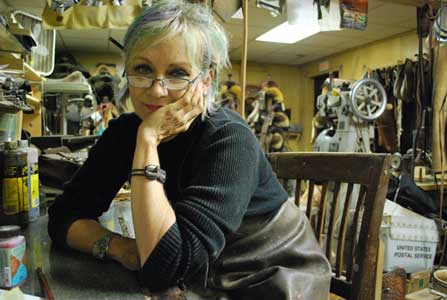
With her brightly streaked hair and spitfire attitude, Wendy Allen has made her mark on the leather industry. Her two personalities — the kind and helpful Wendy, and the tough Wendy Allen she had to become in order to face the male-dominated saddle business — have gained her many dedicated and vocal clients. Allen has been nominated four times to the National Cowgirl Hall of Fame and mentioned by many media outlets, including the New York Times.
A lifelong Texan who grew up in Dallas, she has overcome remarkable hardships in her personal and professional spheres. She made saddles first with her then husband Calvin Allen and later as her own brand, Wendy Allen Saddlery, Inc. Even after an accident severely damaged her dominant left hand, Allen simply taught herself to use her right hand and continued improving her skills.
Here Wendy Allen shares the passion behind her life’s work and the difference she has made for other women in the saddle industry.
Karen Braschayko for Equitrekking: What is your background with horses? How did you get started making saddles?
Wendy Allen: I started riding when I was about three years old. I started on rather large horses, Thoroughbreds, and I’ve done every type of event except polo. I love horses. I love what they can achieve, and I love the people who can bring that out in horses.
I started working with leather when I was seven years old. I found as a young girl that the changes I wanted so my saddle would fit me were not available. The technology just wasn’t there at that time. I made belts, repaired saddles and started to make stamping tools as well. I had this vision in my head of how I wanted my work to be, so I started making my own changes to saddles, including repairs and tooling. I tooled for some of the great saddlemakers in the 1960s.
There was no technology then. There was little thought put into saddles, and I required more comfort. I required things to fit me. I just kept repairing saddles. I’d do leatherwork. Then when I went to college I married Calvin Allen, and I started making saddles.
Equitrekking: Why did you choose saddlery as a career?
Wendy Allen: What I am is an idiot savant, or you could call me just a genius. I’m a kinesiologist of both horse and rider. I can learn more by watching than I can by anybody teaching me. I’ve spent my life, ever since I was seven, understanding the human and equine anatomy and making corrections for it. I fine tune for the bone structure and the muscle structure. I just have a real gift.
I see things differently. I realized that the saddles were made for men. When I started making saddles, I broke that barrier. Saddles don’t all have to fit men who are six feet tall and 195 pounds. They need to fit women. They need to fit kids. They need to fit people of all different builds and anatomical problems.
Also, I saw that in horses. For decades, I’ve fit saddles to the greatest horses in the cutting horse industry. I’ve worked with the strangest backs. I started refining saddle trees in the 1970s, and the Western saddles that you see now are all spinoffs from my designs.
It has always been my heart, my soul and my driving knowledge to better the horse world and the rider’s ability. As a young child, I saw these so clearly. I loved it, and I was blessed enough to make a really good living with it when I got older.
It’ll always be my passion. I’ve had a hard life with this, but it is my passion, and I’ll always make saddles. I love doing it. Anybody who knows me will tell you that they don’t know how I do it, but they know that it’s in my soul to do it.

Equitrekking: What sets your saddles apart from the others?
Wendy Allen: My saddles are known for their extreme comfort, high-tech fit and my ability to enhance riders’ and horses’ performances. I study the equine and human forms structurally. I consider myself a structural specialist. I take my craft and my duty to my clients very seriously. It is my job to make their jobs easier and better. When I see a person, I have the ability to size them up, know exactly what their problems are, and see what they need. Then, I transfer that to a saddle.
I have evolved my structural ability. I consider myself a structural engineer, too. I know structure better than anybody. I know trees better than anybody. I’ve got a new tree now called my Beau Galyean. It’ll be a perfect saddle for the next 25 to 35 years, until the horse’s anatomy changes, hopefully for the better.
I’m very sensitive to the changes in genetics and the changes of riders. They’re getting bigger and heavier, and they come in with more problems because of that. They have limited abilities, and it’s my job to enhance their riding, which is an easy thing for me to do.
It’s the same thing with horses. Now we have American Quarter Horses with very birdlike bones and almost mule-like feet, really high and really tiny. They’re breaking down in their stifles and their hocks. The croup is higher than the withers, and therefore they can’t stop and get the feet out from under them. All I can do is make a saddle to help that.
My saddles are comfortable because I make the saddle fit the person. Once you get the relaxation, that’s 80 percent. They open up their hips, and they drop their tailbone. They no longer concentrate on the problem but on the horse and the job at hand.
You strip the saddle down so the rider can get closer to the horse and feel those muscles. That way they can anticipate the horse’s move and the horse can anticipate the rider’s move. It’s all about being synchronized and being one, the horse and the rider.
You don’t buy a saddle by the weight. You buy it by the technology in it. Saddlemaking is not just some little cobbler in a corner pounding out kind of rough saddles. Saddlemaking today, with the money and the horseflesh involved, is a science. It’s a technology, and I take that very seriously. That’s why people come to me. They have a horse that nothing fits, and they’ll come to me. I more than understand. I anticipate their problems, and I fix them.
When I repair a saddle, I fix a saddle so that in the future it will still be correct and good. You have to forecast for the customer. They’re going to be riding a variety of horses. Some of my saddles are nearly 40 years old, and they are still being ridden in today. They still fit the horses’ backs today.
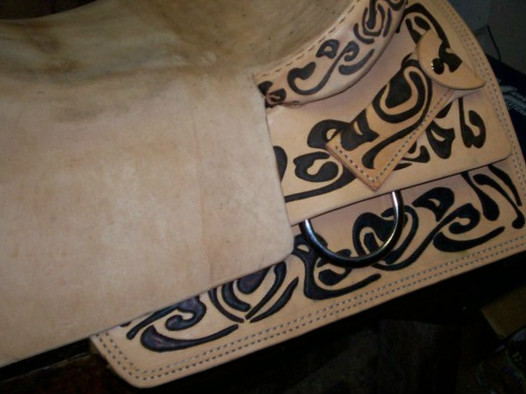
Equitrekking: How do you locate the finest leather?
Wendy Allen: I only use United States products. I believe in America, and therefore I use only the best. There are few tanneries left in the United States. What makes the saddle leather soft is the fish oil content. The fish oil comes from the Columbia River, from the salmon in it. They keep that on a controlled basis, and it’s very expensive. They’ve cut that out almost completely, which makes a stiffer, drier leather. I have to pick and choose.
I can tell the breed of the cattle, the age and the climate that it came from by just looking at the hide. I can smell it and tell you how it was tanned. I can put moisture on it and tell you exactly where it came from. You can’t really put much past me because I’ve spent my entire life studying the body, whether it be cow, equine or human.
I like cold weather cattle. They have a tighter grain. They’re killing them younger now in feedlots, so you don’t get a mature cowhide. You get yearlings, and therefore it takes more leather to make a saddle. It doesn’t have the tightness. Yearlings or two year olds still have kind of a buttery, stretchy skin, and you don’t want stretchy for saddles. You lose a lot. Back in the 1970s and 1980s, you’d get a 35-foot hide, and you could tell that came from an old bull. Once I got a rawhide that was nearly 40 square feet. It had buckshot all through it. I hung it up on the wall as a trophy, because that old bull deserved it.
If I can’t have fun, I don’t do it. I’ve had my friends’ cattle brands come to my shop. I’ll cut them out and send them to them, or I’ll put it in one of their saddles. To me it comes full circle. I’ve been to their ranch, and now I’ve got their cattle on my table. I incorporate it back to them. Stuff like that just makes me think it’s such a small world.
Equitrekking: Have you made saddles for any famous riders? What are some of your favorite stories?
Wendy Allen: There are too many to count — famous actors, professional athletes, country singers and champion riders. I’ve done work for the movies. My career spans almost 40 years and is filled with the famous and notable. I have had a brilliant life with crazy situations and interesting people, to say the least.
I had a secret service agent who had a lower back injury that was so very bad. He wanted to ride, but he thought he couldn’t ride. So I took him in and fixed the saddle for him, and he’s still riding.
A world champion saddle bronc rider came into my shop years ago. He couldn’t get the repairs and modifications to his bronc saddle that he needed. He brought the saddle in and introduced himself to me. I listened very intensely. We have been close ever since. I repaired his saddle, and it helped him win a bunch of money.
Most everybody who comes to me has a problem, and I solve them. I give them the hope they couldn’t find as well as the ability to ride with ease and without any pain.
Equitrekking: What are the biggest perks of the job?
Wendy Allen: I can still embrace my craft with the same love, honor and integrity that I have since I was very young. It is my passion. You throw a problem at me, and I’ll take the challenge. I’ll guarantee it. I can make or repair any saddle for any person or any horse, of any age. I have a God-given talent. It’s what I see, and more so, what I feel. That’s what sets me apart from other saddlemakers. It goes from my soul and into my hands.
When people come to me, that’s my job. I love to help people. I love to see them have a smile on their face. I love to see them at the pay window. That’s where I get satisfaction — in their smiles and when their abilities are raised to a higher scale.
I’ve had tons of stories newspaper stories written on me. I’ve been on television, including Texas Country Reporter. I’m a very well known saddlemaker because I’m kind of eccentric. I’m flamboyant. That’s the Wendy Allen.
I dye my hair with dyes I use for the leather. When I go to horse shows, there is a little fan club to see what color hair I have. Right now it’s blond with a new shade of violet, and it’s got teal in it. It just fits me, and I change the colors at the whim of how I feel. You can tell I’m still a kid at heart. I’ve got that little mischievous look on my face.
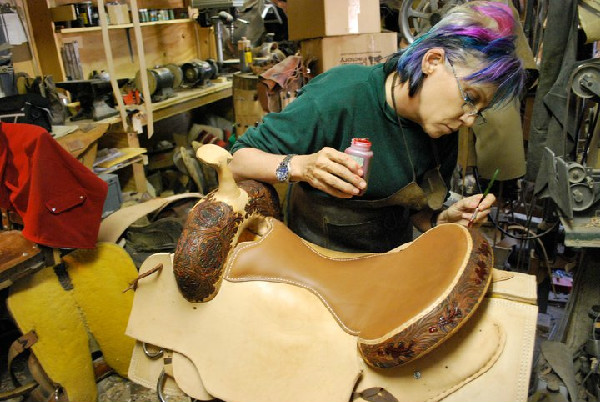
Equitrekking: What is a typical day like for you?
Wendy Allen: I listen to messages, fill custom services for clients from texts and e-mails, and fix problems to help horses and riders.
To make a saddle, a roughout takes me about four days. The fifth day is just to finish it out. Now, that’s at least 10 or 12 hour days. I don’t use any patterns. Everything is hand fit to that tree. I make trees when I know I can’t express what I need to my tree maker.
I like making the ground seat. That’s everything in the saddle. That’s my favorite. That determines how, where and when the rider will come in contact with the horse. It can make or break a rider, and it can make or break a horse. I can make them faster, and I can just do wonders with the ground seat. It’s truly in a category all itself to me. It’s very spiritual. When I work on somebody’s saddle, I have to feel them, and I take on their problems. That’s how I solve them.
Equitrekking: If someone wanted a career in making saddles and tack, what kind of training would you recommend?
Wendy Allen: First, you have to have a serious talent to start with. Then, you need to apprentice with someone you admire as far as talent and styles of making saddles.
I love to take apprentices on. I have so many ideas and ways to make a saddle spin. I want to impart my talents to someone who I think embodies my philosophies. I have no problem telling someone my secrets. I would love to do clinics. I would love to impart my knowledge, so it’s not gone in vain.
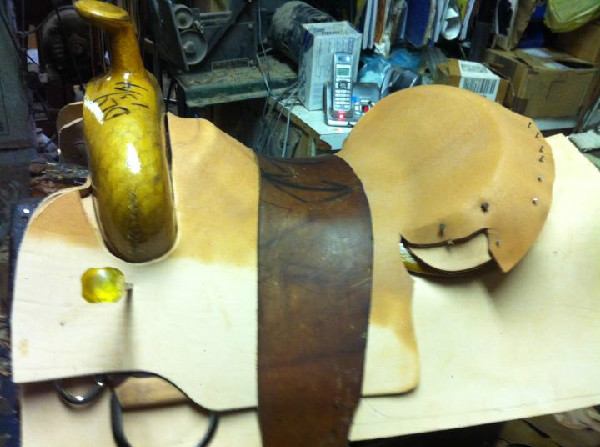
Equitrekking: What are the biggest challenges you’ve faced in the saddle business?
Wendy Allen: Being a woman. I made a lot of changes in the leather world, none as important as opening the field for other women. As a woman, you need to be 10 times as good just to play. I am at the top of my craft. I have done so many things to overcome challenges, but I cannot express the humiliation I have suffered to help open doors and give women a chance.
When I first was helping Calvin make saddles, we went to the Cutting Horse Futurity in 1974. A man came up to me and started asking me questions about a saddle, and I started telling him quite frankly about it. He just looked at me and said, “Little girl, I’d like to speak to the saddlemaker,” and he blew a big booger at my foot. That was the first humiliation.
I remember very well when a guy came in, a friend of both Calvin and me. I put a tree in his saddle. I said, “Here’s your saddle.” He said, “Well where’s Calvin? I’d rather just come back when I know that it was done right.” I looked at him and I said, “Then why don’t you just sit here and wait, because he’s not coming back.”
I’ve had this all my life. After a point, I developed “the look,” so they don’t dare.
About three years ago, I had this man come into my shop. He said, “Do you make these, honey?” I just ground my feet in, gave him “the look,” and said, “Yes sir, I do.” He said, “You do that all by yourself?” When I get mad I get quiet. My neck started crooking over in the death roll. Then this guy said, “Who really makes these saddles?” He went on and on. Finally I said, “Get out of my shop. Don’t you ever come back.”
I’m glad I opened the door for women, because that’s my job. I like to mentor. Now there are lots of female saddlemakers with validation. They wouldn’t have had it in my time. I refused to take no for an answer. I’ve had to be tough.
There’s the Wendy Allen who has “the look” and the death roll, and then there’s Wendy. I’ve got a softer voice, I am the sweetest, most loving, most forgiving person in the world. If somebody comes in the shop and they can’t afford the repairs, I’ll do it. I save used parts. I’ve done lots of free repairs. I just can’t turn people away. My heart and soul couldn’t bear it.
But the Wendy Allen is still there. When I go to cutting horse events, I have to put my Wendy Allen face on. Many people know who I am, but every so often there’ll be a nitwit. It was so bad in the 1970s and 1980s. For some old timers, a saddlemaker has to be a man. Some people believe that a man can make a better saddle. I’ll take the challenge. Give it your best shot. I dare you.
You know what — women have tenacity. We don’t give up. When times get hard, we just get better.
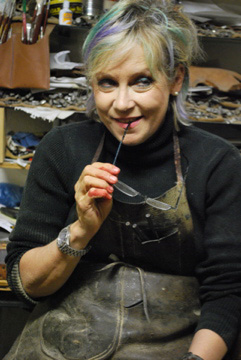
Equitrekking: Are you still a rider and a horse person today?
Wendy Allen: Yep, I have my old cutting mare named Sweet Pea. She is retired now, but I have a young mare I’ll start to ride soon. How can I learn if I don’t get out there and find out what needs to be gained or improved? I love cutting, cow horse and reining.
I truly love dressage. It takes a special horse. That’s the ultimate horsemanship to me. I love to study the anatomy of warmblood horses. Dutch Warmbloods, Lipizzaners and Friesians are my favorites. They are the most beautiful horses, and the way they move, I can never get enough of them. They’re so intelligent, and they have good bone structure.
The main thing that sums me up is that I’m here to help. It’s my job. I’m in the service industry. All I want to do is help people, and my clients are my friends. We’re a tight-knit family. A very large one, but they can come to me at any time. I’m always here to help.
Learn more about Wendy Allen at wendyallensaddlery.com or call (254) 445-4766.
Karen Braschayko is a freelance writer and horse lover who lives in Michigan.




